Appliances
Why Do All Fans Start on High?

Upon initial observation, it might appear perplexing as to why fans typically begin operating on a high setting. Yet, there is a rational reason that explains this widespread characteristic.
Fans are designed to provide optimal airflow and ventilation in various settings, whether it's a home, office, or commercial space. By starting on high, fans quickly circulate air and create a noticeable cooling effect.
This addresses the anticipated objection that starting on a lower speed may be more convenient or comfortable. Additionally, starting on high allows the motor to overcome initial resistance and power surges, ensuring a smooth and efficient operation.
As we delve deeper into the functionality and design of fans, we will explore the factors that influence this default setting and the importance of user convenience and safety.
Key Takeaways
- Fans start on high to quickly circulate air and create a noticeable cooling effect.
- Starting on high allows the motor to overcome initial resistance and power surges.
- High-speed airflow helps clear out stagnant air and heat pockets.
- High fan speed improves air circulation, provides a stronger breeze, and maintains better air quality.
Fan Design and Functionality
When considering fan design and functionality, it's important to understand why fans typically start on high speed. This is primarily due to motor efficiency and airflow direction.
Motor efficiency plays a crucial role in fan design. Starting a fan on high speed allows the motor to operate at its peak efficiency, ensuring optimal performance. By starting on high, the motor can reach its maximum rotation speed quickly and efficiently, minimizing energy wastage. This not only improves the overall efficiency of the fan but also extends its lifespan by reducing wear and tear on the motor.
Another factor to consider is airflow direction. When a fan starts on high speed, it creates a strong and direct airflow. This initial burst of high-speed air helps to clear out any stagnant air or heat pockets that may have accumulated, promoting better air circulation and cooling. Starting on a lower speed mightn't generate enough force to disperse the stagnant air effectively.
Motor Speed Configuration

After understanding the importance of motor efficiency and airflow direction in fan design, it's essential to consider the configuration of motor speed. Motor speed control allows for fan speed adjustment, which is crucial in achieving optimal airflow and comfort levels. Here are four key factors to consider when configuring motor speed:
- Voltage Regulation: Adjusting the voltage supplied to the motor can directly impact its speed. Higher voltage increases fan speed, while lower voltage decreases it. It's important to find the right balance to ensure efficient operation and avoid excessive noise or wear on the motor.
- Pulse Width Modulation (PWM): PWM is a technique used to control motor speed by varying the width of the electrical pulses. By rapidly switching the voltage on and off, the average power delivered to the motor is adjusted, resulting in different speeds. PWM is widely used due to its efficiency and precise speed control capabilities.
- Variable Frequency Drive (VFD): VFDs are commonly used in industrial applications to control motor speed. By altering the frequency of the electrical supply, VFDs can regulate the motor's rotational speed. This allows for precise speed adjustments and helps optimize energy consumption.
- Motor Design: The design of the motor itself plays a significant role in its speed configuration. Motors with multiple speed settings or those specifically designed for variable speed operation provide greater flexibility in adjusting fan speed. Additionally, motor efficiency should be considered to ensure optimal performance and energy savings.
Initial Power Surge Explanation
To understand the phenomenon of the initial power surge in fans, it's important to examine the electrical characteristics and motor behavior during startup. When a fan is turned on, it requires an initial surge of power to overcome inertia and start spinning. This surge is necessary because the motor needs extra torque to get the fan blades moving from a standstill position.
During startup, the electrical characteristics of the fan motor change significantly. Initially, the motor draws a high current as it transitions from a stationary state to a rotating state. This surge in current is due to the large amount of power needed to overcome the resistance and inertia of the fan blades. As the fan gains momentum and reaches its operating speed, the current drawn by the motor decreases to its steady-state value.
Troubleshooting common fan startup issues involves understanding the factors that can affect the initial power surge. One common cause of a high initial power surge is a mechanical obstruction or binding of the fan blades. This can increase the resistance experienced by the motor and result in a higher current draw. Another possible issue is a faulty motor capacitor, which can lead to inadequate starting torque and a prolonged power surge.
Safety and Precautionary Measures
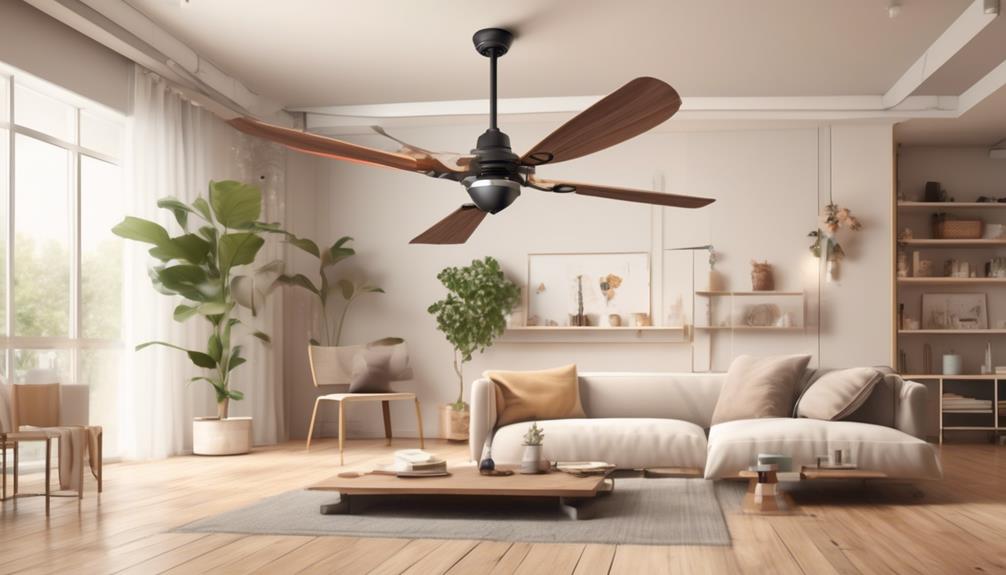
When it comes to high fan speed, there are several benefits that we should consider. It helps to circulate air more effectively, providing better ventilation and cooling.
However, it's important to be cautious with low fan speeds, as they can lead to stagnant air and potential health risks. Proper ventilation is crucial to ensure a safe and comfortable environment.
High Fan Speed Benefits
In order to ensure optimal safety and precautionary measures, it's advisable to initially set the fan speed to its highest setting. Here are the benefits of using high fan speed:
- Improved Air Circulation: High fan speed creates a powerful airflow, allowing for better circulation of air in the room. This helps in reducing stuffiness and ensuring a fresh and comfortable environment.
- Enhanced Cooling Effect: High fan speed helps to create a stronger breeze, resulting in a more effective cooling effect. This is particularly beneficial during hot summer days when you want to quickly cool down a room.
- Better Air Quality: High fan speed promotes better air exchange, helping to remove stale air and circulating fresh air throughout the space. This can help reduce the concentration of allergens, dust, and pollutants in the room.
- Reduced Energy Consumption: Contrary to popular belief, running the fan on high speed for a shorter period can be more energy-efficient than running it on low speed for a longer duration. This is because high fan speed cools the room faster, allowing you to turn off the fan sooner and save energy.
Potential Dangers of Low Speed
Low fan speed can pose potential dangers and compromise safety if not properly monitored and addressed. When fans operate at low speeds, they can contribute to stagnant air, which can lead to a range of health implications due to poor ventilation. Stagnant air provides an environment for the accumulation of airborne pollutants, such as dust, allergens, and harmful chemicals. Inadequate ventilation can also result in increased levels of carbon dioxide and humidity, creating an uncomfortable and potentially hazardous indoor environment.
The dangers of stagnant air extend beyond discomfort. Prolonged exposure to stagnant air can cause respiratory problems, including allergies, asthma, and other respiratory diseases. It can also contribute to the growth of mold and mildew, which can trigger allergic reactions and worsen existing respiratory conditions. Moreover, poor ventilation can lead to an increase in airborne viruses and bacteria, potentially increasing the risk of infections and illnesses.
To ensure safety and prevent these health implications, it's crucial to monitor fan speed and maintain adequate ventilation. Regularly cleaning and maintaining fans, ensuring proper airflow, and using additional ventilation methods when necessary can help mitigate the dangers of low fan speed and promote a healthy indoor environment.
Importance of Proper Ventilation
Proper ventilation is essential to ensure a safe and healthy indoor environment, requiring proactive measures and careful monitoring. To achieve optimal ventilation, it's crucial to install and maintain efficient ventilation systems that promote air quality improvement.
Here are four key reasons why proper ventilation is of utmost importance:
- Removal of pollutants: Ventilation systems help eliminate indoor air pollutants such as dust, allergens, and volatile organic compounds (VOCs), which can cause respiratory issues and allergies.
- Moisture control: Adequate ventilation prevents excessive moisture buildup, reducing the risk of mold and mildew growth. This helps maintain a dry and comfortable environment, protecting both the occupants and the building structure.
- Temperature regulation: Proper ventilation helps regulate indoor temperatures, preventing uncomfortable heat or cold pockets. This promotes a comfortable living or working environment for occupants.
- Enhanced air circulation: Efficient ventilation systems ensure proper air circulation, distributing fresh air throughout the space and reducing the concentration of odors and stagnant air.
User Convenience and Expectations
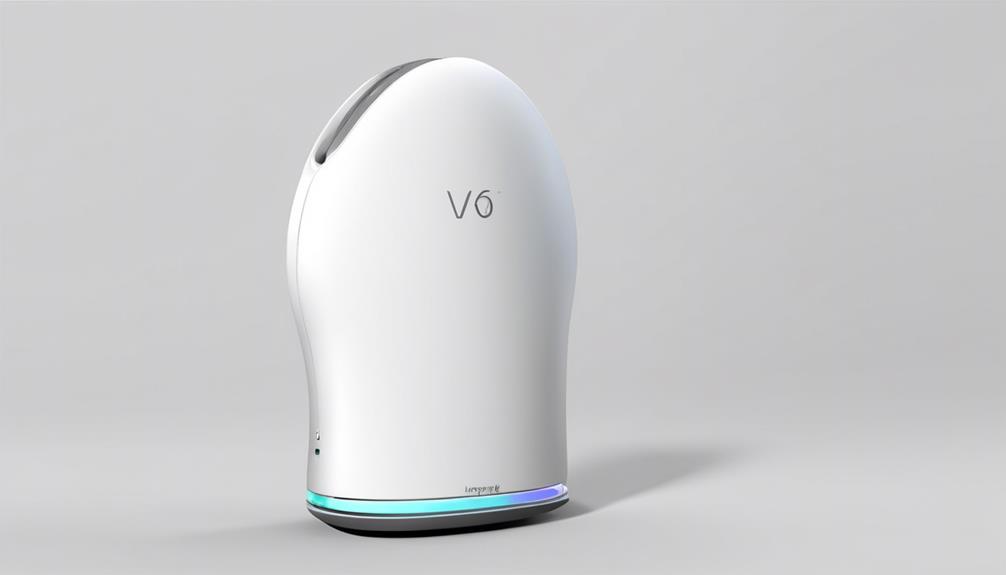
For optimal user convenience and to meet their expectations, it is imperative to understand why fans are commonly started on high. User satisfaction and performance expectations play a crucial role in determining the default setting of fans.
| User Satisfaction | Performance Expectations |
|---|---|
| Higher speed provides a stronger airflow, which users find more effective in cooling down a room. | Users expect fans to deliver maximum performance right from the start. |
| Starting on high satisfies users who prefer a quick blast of cool air upon turning on the fan. | Users assume that the highest setting ensures the fan operates at its maximum capacity. |
| The initial high speed can give users a sense of control and assurance that the fan is functioning properly. | Users may perceive a slower starting speed as a sign of a defective fan or reduced performance. |
| The high speed setting is often associated with powerful cooling capabilities, enhancing user confidence in the fan's ability to cool a room efficiently. | Users may perceive slower starting speeds as less effective in providing immediate relief from heat. |
| Starting on high allows users to quickly create a comfortable environment, addressing their immediate cooling needs. | Users appreciate the convenience of a fan that starts on high, as it saves them time and effort in manually adjusting the speed. |
Understanding the importance of user convenience and expectations when it comes to fan operation is crucial for manufacturers and designers. By starting fans on high, they can ensure user satisfaction, meet performance expectations, and provide a seamless experience for users seeking immediate relief from heat.
Historical Development and Standardization
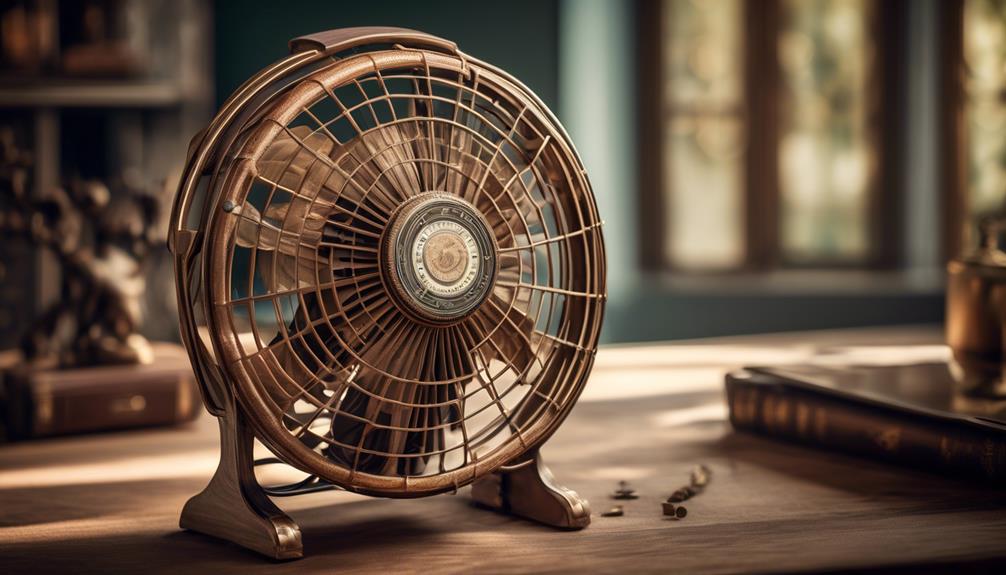
The historical development and standardization of fan operation have undergone significant advancements over the years, contributing to the modern-day user experience. Let's take a closer look at how the standardization of fan operation has evolved and improved over time:
- Standardization Development:
The early days of fan operation saw a lack of standardization, with fans starting on different speeds depending on the manufacturer. This inconsistency created confusion and inconvenience for users, who had to manually adjust the fan speed every time they turned it on.
- Power Surge Explanation:
As technology advanced, manufacturers recognized the need for a standardized starting speed. One reason for fans starting on high is the initial power surge required to overcome the inertia of the fan blades. By starting on high, fans can quickly reach their desired speed and provide immediate cooling or airflow.
- Standardized User Experience:
Over time, manufacturers began to adopt a standardized starting speed for fans, typically starting on high. This standardization ensures that users can easily operate their fans without the need for constant adjustment. It also provides a consistent and predictable user experience across different fan brands and models.
- Improved Efficiency:
Standardizing fan operation has also led to improved energy efficiency. By starting on high, fans can quickly reach their optimal operating speed and distribute air more efficiently. This reduces the amount of time the fan needs to run and ultimately saves energy.
Impact of Fan Speed on Air Circulation
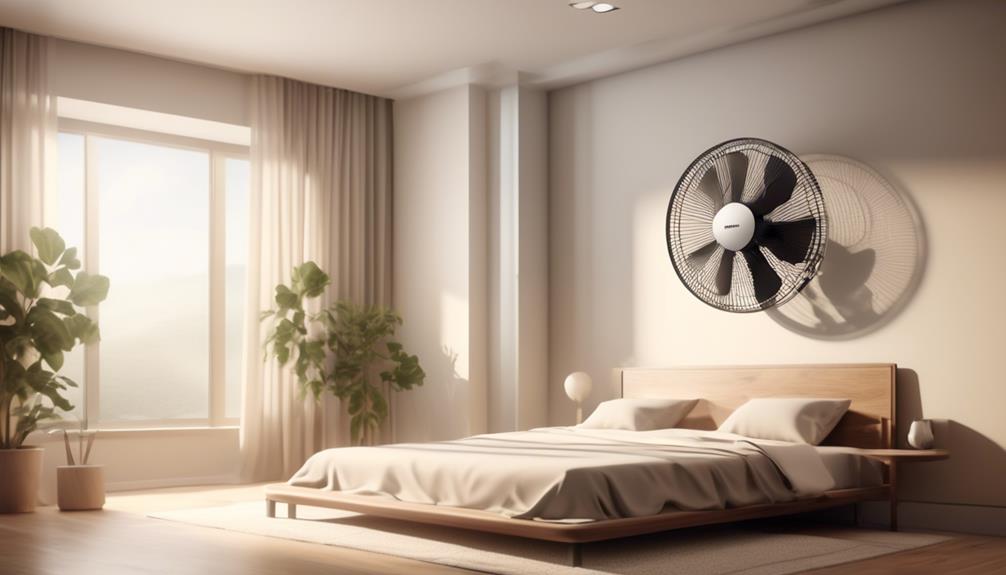
When it comes to fan speed and air circulation, there are several important points to consider.
First, the speed of a fan directly affects the movement of air in a given space. Higher fan speeds generally result in greater air movement, while lower speeds produce a more gentle breeze.
Secondly, there's a correlation between fan performance and speed, with higher speeds often leading to better overall performance.
Lastly, finding the optimal airflow efficiency requires striking a balance between speed and energy consumption, as running a fan at its highest speed may not always be the most efficient option.
Speed and Air Movement
Increasing the speed of a fan enhances air circulation, promoting better ventilation and creating a more comfortable environment. Here's why:
- Increased Airflow: When the fan speed is high, it creates a stronger airflow, effectively moving more air throughout the room. This increased air movement helps to distribute cool or warm air evenly, reducing hot spots and improving overall comfort.
- Improved Ventilation: Higher fan speeds facilitate the exchange of indoor and outdoor air, enhancing ventilation. This is especially beneficial in enclosed spaces or areas with poor air quality, as it helps to remove stale air and replace it with fresh air from outside.
- Enhanced Cooling and Heating Efficiency: By circulating air more rapidly, faster fan speeds enhance the efficiency of cooling and heating systems. This allows them to reach desired temperatures more quickly and maintain them with less energy consumption.
- Personalized Airflow Control: Adjusting the fan speed gives you control over the direction and intensity of the airflow. Whether you prefer a gentle breeze or a stronger gust, being able to regulate the fan speed allows you to customize the air movement to your liking.
Understanding the impact of fan speed on air circulation is essential for mastering airflow control and fan speed regulation. By optimizing fan speed, you can create a well-ventilated, comfortable environment that suits your preferences.
Fan Performance Correlation
After understanding the impact of fan speed on air circulation, it's important to explore the correlation between fan performance and the speed at which it operates. The fan speed correlation plays a crucial role in optimizing airflow.
When a fan operates at high speeds, it typically generates more airflow, resulting in increased cooling or ventilation. However, it's essential to note that fan performance isn't solely dependent on speed. Various factors, such as blade design, motor efficiency, and overall construction, contribute to a fan's performance.
A well-designed fan with efficient airflow optimization can deliver better performance even at lower speeds, making it more energy-efficient and quieter. Understanding the correlation between fan speed and performance is crucial in choosing the right fan for specific applications and ensuring optimal air circulation.
Optimal Airflow Efficiency
To optimize air circulation, the impact of fan speed on airflow efficiency must be carefully considered. When it comes to achieving optimal air circulation, the placement of the fan plays a crucial role. Here are four key factors to take into account:
- Distance from the target area: Placing the fan too far away from the desired space can result in reduced airflow efficiency. It's important to position the fan closer to the area to ensure optimal air circulation.
- Obstructions: The presence of obstacles such as furniture or partitions can impede the airflow. It's essential to clear any obstructions in the fan's path to maximize its effectiveness.
- Fan direction: Adjusting the fan's direction towards the intended area can enhance air circulation. By pointing the fan in the right direction, you can ensure that the air reaches its target efficiently.
- Fan speed: Adjusting the fan speed can significantly impact airflow efficiency. Lower speeds are ideal for gentle airflow, while higher speeds are more suitable for larger spaces or when a stronger breeze is desired.
Considering these factors will help achieve optimal air circulation and create a comfortable environment.
Noise and Vibration Considerations

Considering noise and vibration is an essential aspect when discussing the operation of fans starting on high. Vibration reduction and noise control are crucial factors to consider in order to ensure a smooth and quiet fan operation. When fans start on high, they can generate high levels of vibration and noise, which can be disruptive and undesirable in many applications.
To address vibration reduction, manufacturers employ various techniques. One common approach is the use of vibration isolators or dampers. These components are designed to absorb and minimize vibrations, thereby reducing the potential for noise generation.
Additionally, fan manufacturers may incorporate advanced balancing techniques to minimize vibration during operation. This involves carefully aligning and adjusting the fan components to ensure optimal balance and reduce vibration.
Noise control is another important consideration when fans start on high. Fan manufacturers employ various strategies to minimize noise output. These can include the use of aerodynamic design features, such as specially designed fan blades and housings, which help to reduce turbulence and minimize noise generation.
Additionally, manufacturers may incorporate sound-absorbing materials within the fan structure to further reduce noise output.
Energy Efficiency and Power Consumption

Energy efficiency and power consumption are important factors to consider when examining the operation of fans starting on high. Understanding these factors can help us make informed decisions about our energy usage and optimize the performance of our fans. Here are some key points to consider:
- Motor efficiency: The efficiency of the fan's motor plays a crucial role in determining its energy consumption. Motors that are designed for higher efficiency can help reduce power consumption and save energy in the long run. When purchasing a fan, look for models with high motor efficiency ratings.
- Energy-saving tips: There are several energy-saving tips that can be applied to fans starting on high. One effective strategy is to only use the fan when necessary. For example, instead of running the fan continuously, consider using it only during the hottest parts of the day. Additionally, regular maintenance, such as cleaning the fan blades and ensuring proper lubrication, can help improve its efficiency and reduce power consumption.
- Power consumption: Fans starting on high tend to consume more power initially compared to when they're operating at lower speeds. This spike in power consumption is due to the increased load on the motor when starting from a higher speed setting. However, once the fan reaches the desired speed, the power consumption stabilizes.
- Overall energy efficiency: While starting fans on high may result in higher initial power consumption, the overall energy efficiency of the fan depends on various factors such as motor efficiency, fan design, and usage patterns. Evaluating these factors can help determine the most energy-efficient fan for your needs.
Relationship Between Fan Speed and Cooling Effect
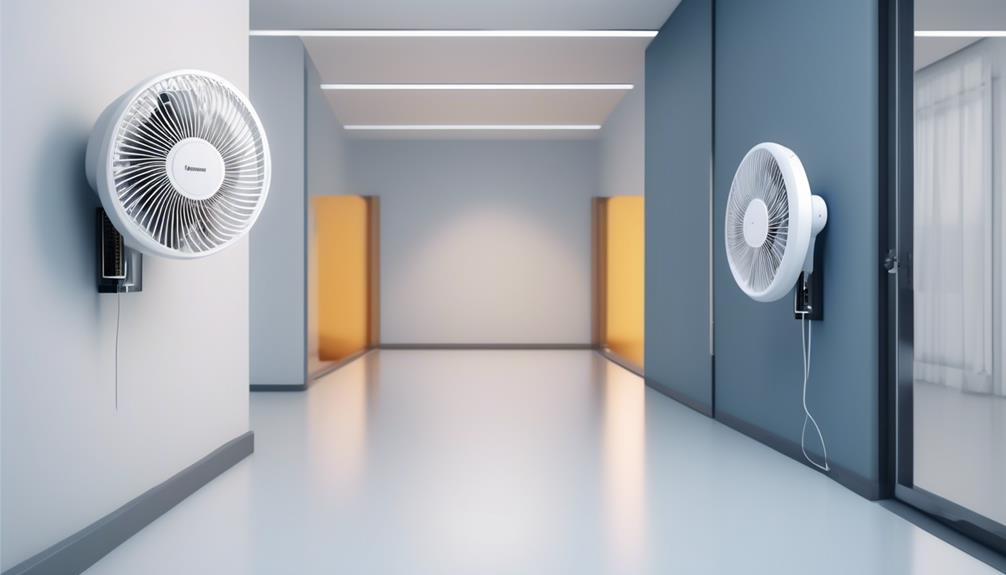
When examining the operation of fans starting on high and their impact on cooling, it's important to understand the relationship between fan speed and the cooling effect.
Fan speed plays a crucial role in determining the effectiveness of cooling. As the fan speed increases, the cooling effect also increases. This is due to the fact that higher fan speeds result in greater air circulation, which helps in dissipating heat from the surroundings.
The correlation between fan speed and temperature is quite straightforward. When the fan speed is set to high, it creates a stronger airflow, allowing for more efficient heat transfer. This results in a quicker reduction in temperature within the room.
However, it's worth noting that increasing the fan speed also leads to higher energy consumption. The more power the fan uses, the higher the energy consumption. Therefore, finding the right balance between fan speed and energy efficiency is essential.
To optimize the cooling effect while minimizing energy consumption, it's recommended to adjust the fan speed according to the desired level of cooling required. By carefully considering the temperature and energy requirements, one can strike a balance between achieving an optimal cooling effect and minimizing energy usage.
Influence of Fan Blade Design

When it comes to the influence of fan blade design on the performance of fans, there are several key points to consider.
First, the shape of the blades directly affects the airflow generated by the fan, with different blade designs resulting in varying levels of air movement.
Second, the efficiency of the fan is closely tied to its blade design, as certain shapes can optimize the transfer of energy from the motor to the airflow.
Lastly, noise reduction techniques can also be incorporated into the blade design, helping to minimize the sound produced by the fan during operation.
Blade Shape and Airflow
The design of fan blades plays a crucial role in determining the airflow and overall performance of a fan. When it comes to blade shape, there are several factors that influence the airflow generated by a fan:
- Blade Material: The choice of blade material affects the efficiency and durability of the fan. Materials such as plastic, aluminum, or composite alloys are commonly used due to their lightweight nature and resistance to corrosion.
- Airfoil Shape: Fan blades are often designed with an airfoil shape, similar to that of an airplane wing. This shape helps to create a pressure difference between the front and back of the blade, resulting in increased airflow and reduced turbulence.
- Blade Pitch: The angle at which the blades are set relative to the fan's axis, known as the blade pitch, also affects airflow. A steeper pitch can generate more airflow, but it may also require more power to operate.
- Blade Sweep: The sweep or curvature of the blades determines the amount of air that the fan can move in a single rotation. Blades with a larger sweep can move more air, resulting in higher airflow and cooling performance.
Efficiency and Performance
Fan blade design has a significant impact on the efficiency and performance of a fan, influencing factors such as airflow, noise level, and power consumption. The shape, angle, and curvature of the blades determine how effectively the fan can move air. Blades with a steeper angle generate more airflow, but also increase noise and power consumption. On the other hand, blades with a shallower angle produce less airflow, but are quieter and consume less power.
Additionally, fan blade design plays a crucial role in the effectiveness of fan speed control, allowing for precise adjustments to match specific cooling requirements. Some fans also incorporate an energy-saving mode, which optimizes blade design and speed control to reduce power consumption while maintaining adequate airflow.
Therefore, selecting the right fan blade design is essential for achieving optimal efficiency and performance in cooling systems.
Noise Reduction Techniques
As we explore the influence of fan blade design on noise reduction techniques, it becomes evident that the shape, angle, and curvature of the blades play a crucial role in minimizing unwanted noise while maintaining optimal efficiency and performance.
Here are four ways in which fan blade design can contribute to noise reduction and user convenience:
- Blade Shape: By carefully designing the shape of the blades, manufacturers can minimize the turbulence and airflow disruptions that lead to noise generation. Smooth, streamlined blade profiles help to reduce noise levels by promoting laminar airflow.
- Blade Angle: The angle at which the blades are positioned also affects noise levels. A steeper blade angle can increase noise generation, while a shallower angle can help to reduce turbulence and noise.
- Blade Curvature: The curvature of the blades can impact both airflow efficiency and noise levels. Optimizing the curvature can reduce noise by reducing turbulence and ensuring a smoother flow of air.
- Blade Material: The choice of blade material can also influence noise levels. Materials that are lightweight and have good damping properties can help to absorb vibrations and reduce noise.
Importance of Fan Speed Controls
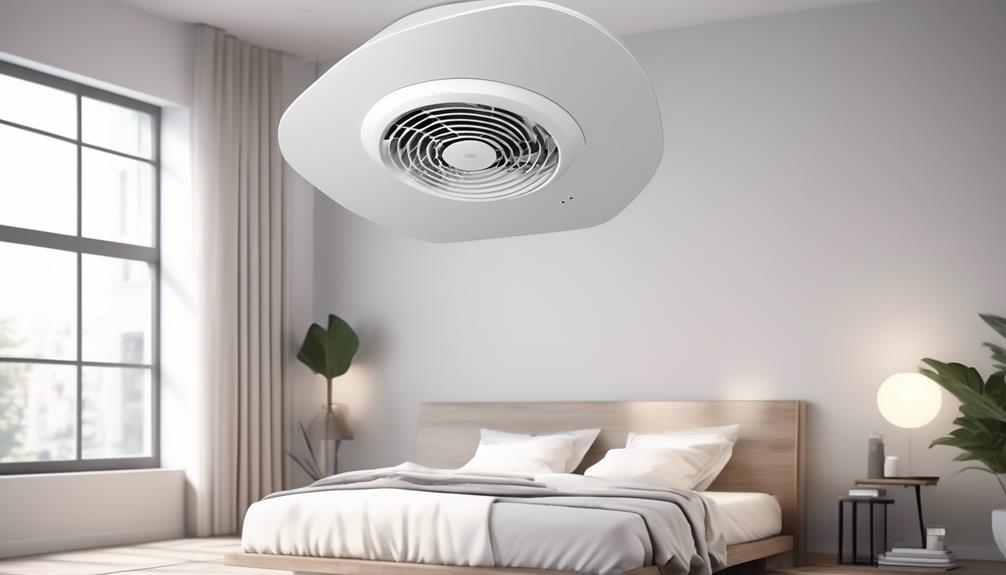
When considering the efficiency and effectiveness of a cooling system, it's imperative to recognize the significant role that fan speed controls play. Motor speed control is an integral part of optimizing the performance of fans and reducing energy consumption.
Fan speed controls allow for the adjustment of the rotational speed of the fan's motor. This control over the motor speed directly affects the airflow generated by the fan. By regulating the speed, the fan can be fine-tuned to match the cooling requirements of the system. This ensures that the fan operates at the optimal speed, providing the necessary cooling while minimizing energy consumption.
By adjusting the fan speed according to the cooling needs, excess energy consumption can be avoided. When the cooling demand is low, reducing the fan speed can significantly reduce the power consumed by the motor. Conversely, when the system requires higher cooling capacity, increasing the speed of the fan can ensure the necessary airflow is maintained.
In addition to energy savings, fan speed controls also contribute to noise reduction. By allowing the fan to operate at lower speeds when possible, the noise generated by the motor and the airflow is reduced. This is particularly important in environments where noise levels need to be kept to a minimum.
Technological Advancements and Smart Fan Features
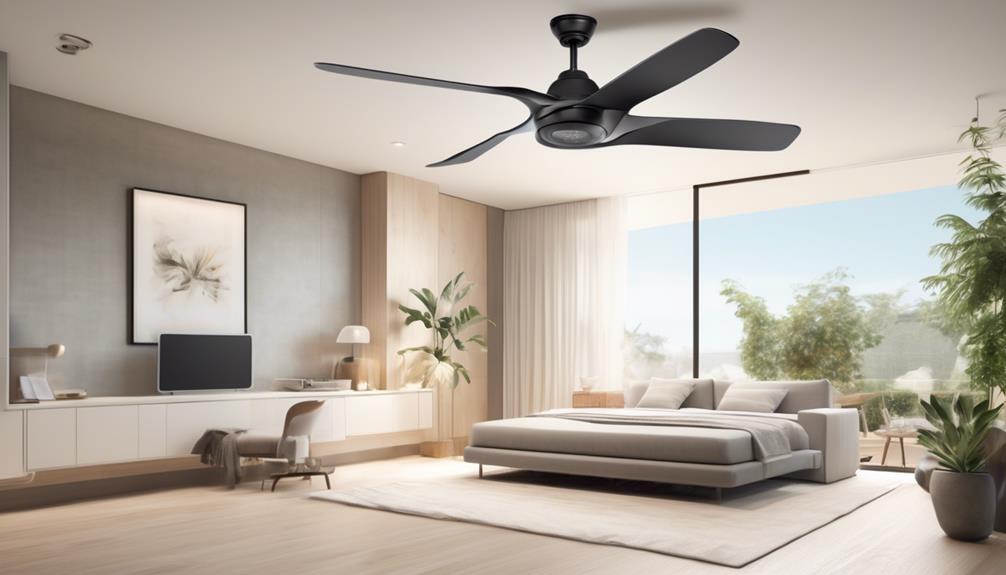
With advancements in technology, the capabilities and features of fans have evolved to incorporate smart functionalities that enhance their performance and efficiency. Smart fan technology has revolutionized the way we control and manage our fans, providing us with greater control over their speed and energy consumption.
Here are four key advancements in smart fan technology and their impact on energy consumption:
- Variable Speed Control: Smart fans now come equipped with variable speed control, allowing users to adjust the fan speed according to their needs. By running the fan at a lower speed when cooling requirements are low, energy consumption can be significantly reduced.
- Automated Speed Adjustment: Some smart fans are equipped with sensors that can automatically adjust the fan speed based on the room temperature or humidity levels. This ensures optimal cooling efficiency while minimizing energy waste.
- Energy Monitoring and Reporting: Smart fans now have the capability to monitor and report energy usage. This feature allows users to track their energy consumption and make informed decisions about fan usage to optimize efficiency.
- Integration with Smart Home Systems: Smart fans can now be integrated with smart home systems, enabling users to control and schedule their fans remotely. This integration allows for greater energy management and ensures that fans are only running when necessary.
These advancements in smart fan technology have made it easier than ever to control and optimize fan speed, resulting in reduced energy consumption and improved efficiency.
Troubleshooting Common Fan Start-Up Issues
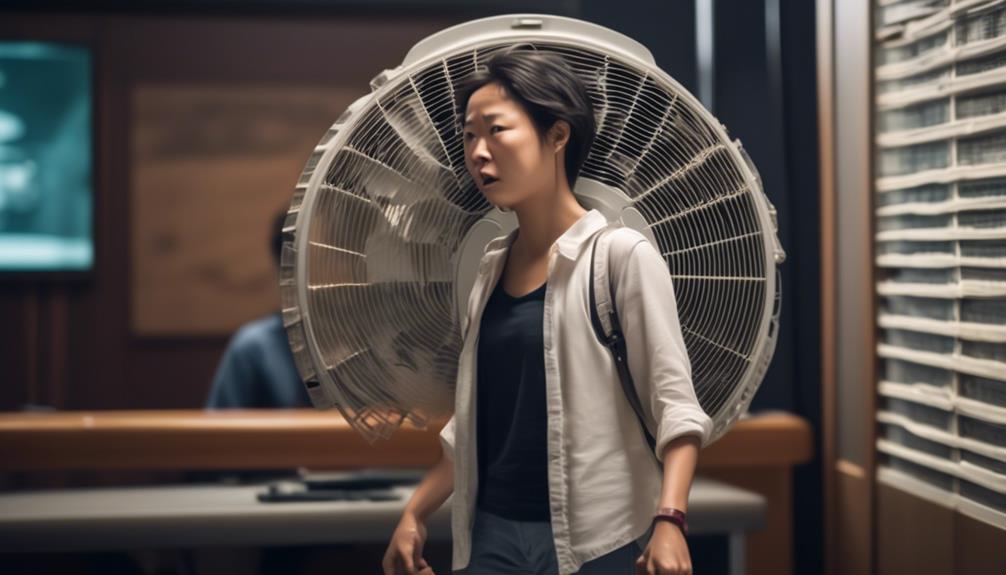
To troubleshoot common fan start-up issues, we can employ a systematic approach to identify and resolve any potential problems.
One common issue is a motor malfunction, which can prevent the fan from starting up properly. If the motor isn't functioning correctly, it may not receive the necessary power to start the fan. In such cases, checking the power supply and ensuring it's supplying the correct voltage is the first step.
Additionally, inspecting the motor's wiring connections for any loose or damaged wires is crucial. Sometimes, a motor overload protector may trip due to excessive heat or current, causing the fan to not start. In this case, resetting the overload protector or replacing it if necessary can resolve the issue.
Another troubleshooting tip is to check the fan's capacitor, which stores electrical energy and helps the motor start. If the capacitor is faulty, it may need to be replaced.
Lastly, lubricating the fan's bearings can also help resolve start-up issues, as lack of lubrication can cause the motor to seize up.
Is the High Speed Setting Standard for Fans in Spain as Well?
Yes, the high-speed setting is a standard feature for fans in Spain. The “spanish fan name in Spain” is typically equipped with various speed settings to provide maximum comfort in hot weather. These fans are a popular choice for many households in Spain due to their effective cooling capabilities.
Frequently Asked Questions
How Can I Adjust the Speed of My Fan?
When it comes to adjusting the speed of your fan, there are various ways to do so depending on the model.
Different fan models offer different speed adjustment options, such as manual dials, remote controls, or even smart home integration.
By utilizing these features, you can easily customize the airflow to your desired level.
It's important to consult the user manual or manufacturer's instructions for specific guidance on how to adjust the speed of your particular fan model.
What Are Some Safety Precautions to Keep in Mind While Using a Fan?
When it comes to using fans, it's important to keep safety in mind. To ensure a safe experience, here are some key tips to follow.
First, always make sure the fan is placed on a stable surface to prevent accidents.
Second, regularly clean the fan to avoid dust buildup and maintain its efficiency.
Additionally, remember to keep cords away from any potential hazards.
Can a Fan's High Starting Speed Affect Its Overall Energy Efficiency?
Fan speed control plays a crucial role in the overall energy efficiency of a fan.
Starting a fan on high speed can have a significant impact on its energy consumption. When a fan is initially set on high, it requires more power to overcome the initial inertia and reach its maximum speed.
This increased power consumption can result in higher energy usage and reduced efficiency. Therefore, it's advisable to start fans on a lower speed setting to minimize energy consumption and maximize efficiency.
What Are Some Common Troubleshooting Tips for Fan Start-Up Issues?
When troubleshooting fan start-up issues, there are a few common tips to consider.
First, check the power source and ensure it's properly connected.
Next, inspect the fan blades for any obstructions or debris that may be preventing smooth operation.
Additionally, make sure the fan's speed settings are correctly adjusted and not stuck on high.
If these steps don't resolve the issue, it may be necessary to contact a professional technician for further assistance.
Are There Any Technological Advancements or Smart Features Available in Modern Fans?
Smart fan features have revolutionized the way we experience comfort. With adjustable speed settings, modern fans allow us to customize the airflow according to our preferences. This not only enhances our comfort but also saves energy by preventing unnecessary power consumption.
Additionally, smart fans often come equipped with sensors that automatically adjust the speed based on temperature and humidity levels, ensuring optimal comfort at all times. These technological advancements provide us with a more efficient and personalized cooling experience.
Conclusion
In conclusion, while it may seem frustrating that fans always start on high, this design choice is intended to ensure maximum airflow and cooling efficiency.
Although it may initially create a sudden burst of power, this is a necessary feature to provide immediate relief in hot environments.
By understanding the functionality and purpose behind this design, users can appreciate the benefits it offers and adjust their expectations accordingly.
So, next time your fan starts on high, remember it's simply working to keep you cool.
- About the Author
- Latest Posts
Introducing Ron, the home decor aficionado at ByRetreat, whose passion for creating beautiful and inviting spaces is at the heart of his work. With his deep knowledge of home decor and his innate sense of style, Ron brings a wealth of expertise and a keen eye for detail to the ByRetreat team.
Ron’s love for home decor goes beyond aesthetics; he understands that our surroundings play a significant role in our overall well-being and productivity. With this in mind, Ron is dedicated to transforming remote workspaces into havens of comfort, functionality, and beauty.
Appliances
3 Essential Tips for RV-Friendly Portable Washers

- Pros and cons of using eco friendly laundry detergent in a portable washer.
- Tips for preventing detergent residue buildup in a portable washer
Are you exhausted from constantly looking for laundromats during your RV trips? We get it. That’s why we’re here to provide three key tips for RV-friendly portable washing machines.
While you might be thinking, ‘Do I really need a portable washer?’ trust us, having one on your RV can be a game-changer. In this guide, we’ll show you how to choose the right size washer that fits your RV’s limited space, understand the power and water requirements to ensure smooth operation, and provide you with maintenance and cleaning tips to keep your washer running efficiently.
So, let’s dive in and master the art of laundry on the road!
Key Takeaways
- Consider the laundry capacity needed for your RV.
- Look for compact and lightweight options with space-saving features.
- Choose a portable washer with high energy efficiency and water conservation features.
- Regularly maintain and clean your portable washer using recommended cleaning products.
Choosing the Right Size
One of the first considerations when selecting a portable washer for our RV is determining the appropriate size. Portable washer features and space-saving options play a crucial role in making this decision. When it comes to size, it’s important to find a washer that fits well within the limited space of an RV, while still providing enough capacity to meet our laundry needs.
To begin with, portable washers come in a range of sizes, typically measured in pounds of laundry capacity. It’s essential to consider the amount of laundry we anticipate doing on a regular basis. While a smaller capacity may be suitable for individuals or couples, larger families might require a washer with a higher capacity to accommodate their laundry demands.
Additionally, it’s important to consider the physical dimensions of the washer. RVs have limited space, so opting for a compact and lightweight washer can help maximize the available room. Some portable washers are designed with space-saving features such as folding handles, detachable components, or even stackable options that can fit neatly into tight spaces.
Understanding Power and Water Requirements
When considering the power and water requirements for our RV-friendly portable washer, we need to understand the necessary resources for optimal performance.
Energy efficiency is an important factor to consider when choosing a portable washer for your RV. Look for models that have a high Energy Star rating, as this indicates that they consume less energy and can help you save on your electricity bills.

Additionally, portable washer features such as load sensing technology and adjustable water levels can help you conserve water. These features ensure that the washer only uses the amount of water necessary to clean your laundry, which is particularly crucial when you have limited water supply in your RV.
It’s also important to check the power requirements of the portable washer. Make sure that the washer is compatible with the power source available in your RV, whether it’s a standard 120-volt outlet or a 12-volt DC power source.
Understanding the power and water requirements of your RV-friendly portable washer won’t only help you achieve optimal performance but also contribute to energy and water conservation.
Maintenance and Cleaning Tips
Let’s talk about how to properly maintain and clean your RV-friendly portable washer. Taking care of your portable washer is essential to ensure its longevity and optimal performance. Regular maintenance and cleaning will help prevent any potential issues and keep your machine running smoothly. Here are some common troubleshooting tips and recommended cleaning products to keep in mind:
| Common Troubleshooting | Recommended Cleaning Products |
|---|---|
| Leaking water | Vinegar and water mixture |
| Excessive noise | Mild detergent |
| Drum not spinning | Baking soda |
| Error codes | Citric acid |
If you encounter a problem such as leaking water, try using a mixture of vinegar and water to clean the machine’s seals and hoses. For excessive noise, use a mild detergent to clean the drum and remove any debris that may be causing the noise. If the drum is not spinning, try using baking soda to remove any buildup that may be hindering its movement. Lastly, if you receive error codes, using citric acid in the detergent compartment can help clean the sensors and resolve the issue.
Remember to always refer to your portable washer’s manual for specific maintenance instructions and troubleshooting tips. By following these guidelines and using the recommended cleaning products, you can keep your RV-friendly portable washer in great condition and enjoy clean laundry on your travels.
Frequently Asked Questions
How Long Does It Typically Take to Wash a Full Load of Laundry Using a Portable Washer?
Typically, it takes around 30 to 45 minutes to wash a full load of laundry using a portable washer.
However, it’s important to consider the capacity limitations of these machines. Most portable washers have a smaller capacity compared to traditional washers, so it may take longer if you have a larger load.
It’s always a good idea to follow the manufacturer’s instructions and not overload the machine to ensure efficient and effective washing.
Can I Use Regular Laundry Detergent in a Portable Washer, or Do I Need to Use a Specific Type?
Yes, you can use regular laundry detergent in a portable washer. However, there are some pros and cons to consider.
Using eco-friendly laundry detergent in a portable washer is a great option for those who want to reduce their environmental footprint. It can be gentler on your clothes and safer for the environment.
However, some eco-friendly detergents may not be as effective at removing tough stains. To prevent detergent residue buildup, make sure to use the recommended amount of detergent and run an extra rinse cycle if needed.
Is It Safe to Leave a Portable Washer Unattended While It’s Running?
Safety precautions should be taken when using a portable washer unattended. There are potential risks involved, such as water leakage or electrical malfunctions. It’s important to follow the manufacturer’s instructions and guidelines for safe operation.
Some tips to minimize risks include ensuring a stable surface, avoiding overloading the machine, and regularly checking for any signs of damage.
It’s always best to err on the side of caution when it comes to leaving a portable washer running without supervision.
Can I Wash Delicate Fabrics, Such as Silk or Lace, in a Portable Washer?
When it comes to washing delicate fabrics like silk or lace in a portable washer, there are a few things to keep in mind.
Firstly, check the manufacturer’s instructions to ensure that your specific model is suitable for these types of fabrics.
Secondly, use a gentle cycle and cold water to minimize any potential damage.
Lastly, consider placing delicate items in a mesh laundry bag for added protection.
With these precautions, you can safely wash your delicate fabrics in an RV-friendly portable washer.

How Noisy Are Portable Washers When in Operation?
When it comes to the noise level of portable washers, it’s important to consider their energy efficiency as well. These machines are designed to be compact and efficient, so they tend to operate quietly. While they do make some noise during operation, it’s typically minimal and shouldn’t disturb your RV neighbors or disrupt your peaceful campsite.
Plus, their energy efficiency means you can enjoy clean clothes without draining your RV’s power supply.
Conclusion
In conclusion, choosing the right size portable washer for your RV, understanding power and water requirements, and following maintenance and cleaning tips are essential for a smooth laundry experience on the road.
By coincidence, we stumbled upon a fellow traveler at a campsite who’d just purchased a portable washer based on our article. They were thrilled with the convenience and efficiency it provided.
So, take these tips into consideration and enjoy clean clothes wherever your adventures take you!
- About the Author
- Latest Posts
Introducing Charles, the Editor in Chief at ByRetreat, whose passion for interior design and editorial excellence elevates every remote workspace to new heights. With his keen eye for detail, impeccable taste, and expertise in design, Charles brings a wealth of knowledge and creativity to the ByRetreat team.
As the Editor in Chief of a renowned lifestyle blog, Charles has honed his skills in curating captivating content and staying up-to-date with the latest trends in interior design. His deep understanding of aesthetics and the power of storytelling through design enables him to create remote workspaces that are not only visually stunning but also rich in personality and meaning.
Appliances
4 Smart Tips for Extended Commercial Appliance Warranties

Did you realize that nearly 80% of commercial appliance malfunctions happen after the manufacturer’s warranty runs out? As business operators, we grasp the significance of safeguarding our assets and reducing unforeseen costs.
That’s why we have compiled four smart tips for extended commercial appliance warranties that will help you make informed decisions and ensure the longevity of your appliances.
In this guide, we will discuss choosing the right warranty provider, understanding coverage and exclusions, evaluating the cost and value, and maximizing the benefits of extended warranties.
By following these tips, you can have peace of mind knowing that your appliances are protected and your business operations can continue smoothly.
Let’s dive in and master the art of extended warranties!
Key Takeaways
- Choose a warranty provider with a good reputation and track record.
- Understand the coverage details and limitations of the warranty.
- Evaluate the cost and value of extended warranties.
- Maximize the benefits by understanding the claim process and maintaining your appliances.
Choosing the Right Warranty Provider
When selecting a warranty provider for extended commercial appliance warranties, we should consider their reputation and track record in the industry. Identifying reputable providers is crucial to ensure that we’re dealing with a company that has a history of delivering on their promises and providing excellent service to their customers. A reputable provider will have a strong presence in the market and positive reviews from satisfied clients. They’ll also have a proven track record of handling warranty claims efficiently and resolving issues promptly.
In addition to reputation, it’s important to compare warranty terms offered by different providers. We should carefully review the terms and conditions of each warranty to ensure that they meet our specific needs and requirements. This includes understanding the coverage provided, such as if it includes parts and labor costs, and the duration of the warranty. It’s also important to consider any limitations or exclusions that may apply.
Understanding Coverage and Exclusions
To fully understand the extent of coverage and any exclusions, we should carefully review the warranty terms and conditions for our extended commercial appliance warranties. Many people have common misconceptions about what’s covered under these warranties, which is why it’s so important to read the fine print. Here are some key points to consider:
- Scope of coverage: It’s crucial to understand what types of repairs or replacements are included in the warranty. This may vary depending on the provider and the specific appliance being covered. Some warranties may only cover certain parts or components, while others may offer more comprehensive coverage.
- Exclusions: Even though warranties provide coverage, there are often exclusions stated in the terms and conditions. These exclusions may include damage caused by misuse, neglect, or unauthorized repairs. It’s important to be aware of these exclusions to avoid any surprises when filing a claim.
- Duration of coverage: Extended commercial appliance warranties can vary in terms of their duration. Some warranties may provide coverage for a fixed period of time, while others may offer coverage until a certain number of repairs or replacements have been made. Understanding the duration of coverage can help us plan for future maintenance and repairs.
- Claim process: Familiarizing ourselves with the claim process is essential. This includes knowing who to contact, what documentation is required, and any specific procedures that need to be followed to ensure a smooth and efficient claim experience.
Evaluating the Cost and Value
To determine the cost-effectiveness of extended commercial appliance warranties, we need to assess their overall value. When weighing options and considering budget considerations, it is essential to evaluate the benefits and drawbacks of purchasing extended warranties for your appliances. To help you make an informed decision, we have created a table that outlines the key factors to consider:
| Factors to Consider | Benefits | Drawbacks |
|---|---|---|
| Coverage | Extended protection beyond the manufacturer’s warranty period | Additional cost |
| Repair Costs | Potential savings on repair expenses | Warranty cost may outweigh repair costs |
| Peace of Mind | Assurance that your appliances are protected | Limited likelihood of appliance failure |
By considering these factors, you can determine whether the cost of an extended warranty is justified by its value. It is important to note that budget considerations should not be the sole determining factor. While extended warranties may come at an additional cost, they can provide peace of mind and potential savings on repair expenses.
In the next section, we will explore strategies for maximizing the benefits of extended warranties, ensuring that you get the most value out of your investment.
Maximizing the Benefits of Extended Warranties
To maximize the benefits of extended warranties, we can employ strategies that optimize our investment. By understanding the claim process and exploring renewal options, we can ensure that our commercial appliance warranties provide us with the maximum value and protection.
Here are some smart tips for maximizing the benefits of extended warranties:
- Thoroughly understand the claim process: Familiarize yourself with the steps involved in filing a claim. Know the required documentation, such as proof of purchase and warranty information. By being prepared, you can expedite the claim process and minimize downtime.
- Regularly maintain your appliances: Proper maintenance is crucial for the longevity and performance of your commercial appliances. Follow the manufacturer’s guidelines for cleaning, servicing, and inspections. Regular maintenance not only extends the lifespan of your appliances but also helps prevent potential issues that may require warranty claims.
- Research renewal options: When your extended warranty is about to expire, explore renewal options offered by the warranty provider. Some providers offer extended renewal plans with additional coverage, giving you continued peace of mind and protection for your investment.
- Keep warranty documents organized: Maintain a dedicated folder or digital file for all your warranty documents. This ensures easy access to necessary information when filing a claim or renewing your warranty.
Frequently Asked Questions
How Can I Extend the Warranty on My Commercial Appliance if It’s Already Expired?
To extend the warranty on your commercial appliance after it has expired, there are several renewal options available.
You can contact the manufacturer or a third-party warranty provider to inquire about their extended warranty programs. They may offer coverage plans specifically designed for appliances with expired warranty coverage.
It’s important to carefully review the terms and conditions, as well as the cost, of these extended warranty options to ensure they meet your needs and budget.
Are There Any Specific Requirements or Limitations for Obtaining an Extended Warranty for Commercial Appliances?
When obtaining an extended warranty for commercial appliances, it’s important to be aware of the common exclusions in extended warranty coverage. These may include wear and tear, cosmetic damage, and misuse or negligence.
To choose the right extended warranty, consider factors such as the length of coverage, cost, and reputation of the provider.
It’s also crucial to thoroughly read and understand the terms and conditions of the warranty to avoid any surprises down the line.
Can I Transfer My Extended Warranty to a New Owner if I Sell My Commercial Appliance?
Yes, you can transfer your extended warranty to a new owner if you sell your commercial appliance. This ensures that the warranty coverage for used appliances continues with the new owner.
It’s important to check the specific requirements and limitations of your extended warranty to ensure a smooth transfer process. By transferring the warranty, you provide peace of mind to the new owner and protect them against any unexpected repair or replacement costs.
What Happens if My Commercial Appliance Breaks Down Multiple Times During the Extended Warranty Period?
If your commercial appliance breaks down multiple times during the extended warranty period, you may be eligible for claim reimbursement. The repair or replacement timeline will depend on the terms and conditions of your warranty.
It’s important to thoroughly review the warranty agreement to understand the process and any limitations. Our team is here to help ensure that your claims are handled efficiently and that you receive the necessary repairs or replacements in a timely manner.
Is There a Limit to the Number of Claims I Can Make Under an Extended Warranty for My Commercial Appliance?
There are limitations to the number of claims we can make under an extended warranty for our commercial appliance.
However, it’s important to note that extended warranties offer numerous benefits for commercial appliances. They provide peace of mind by covering repairs and replacements, reducing downtime and maintenance costs.
Conclusion
In conclusion, when it comes to extended commercial appliance warranties, there are several crucial considerations to keep in mind.
Firstly, choosing the right provider is essential. It’s important to research and compare different warranty providers to ensure they have a good reputation and offer comprehensive coverage.
Understanding coverage and exclusions is also crucial. Businesses should carefully review the terms and conditions of the warranty to know exactly what is covered and what is not. This will help avoid any surprises or disappointments down the line.

Evaluating cost and value is another important factor. Businesses should consider the cost of the warranty in relation to the potential repair or replacement costs of the appliances. They should also assess the value of the warranty by considering additional benefits such as extended service hours or priority service.
Lastly, maximizing benefits is key. Businesses should take advantage of all the benefits offered by the warranty, such as regular maintenance or discounted repairs. This will help ensure the appliances are well-maintained and any issues are addressed promptly.
By following these smart tips, businesses can make informed decisions that protect their investments. Just like a well-oiled machine, a well-chosen warranty can provide peace of mind and keep the business running smoothly. So don’t leave your appliances vulnerable, take action and secure their longevity today.
- About the Author
- Latest Posts
Introducing Charles, the Editor in Chief at ByRetreat, whose passion for interior design and editorial excellence elevates every remote workspace to new heights. With his keen eye for detail, impeccable taste, and expertise in design, Charles brings a wealth of knowledge and creativity to the ByRetreat team.
As the Editor in Chief of a renowned lifestyle blog, Charles has honed his skills in curating captivating content and staying up-to-date with the latest trends in interior design. His deep understanding of aesthetics and the power of storytelling through design enables him to create remote workspaces that are not only visually stunning but also rich in personality and meaning.
Appliances
3 Essential DIY HVAC Maintenance Tips Unveiled

Ah, the pleasures of tending to our HVAC systems! We understand the excitement of dedicating our valuable time to the upkeep and repair of these marvelous devices. But do not worry, dear reader, as we have revealed the tips to becoming skilled at DIY HVAC maintenance.
In this guide, we will unveil three essential tips that will ensure your HVAC system remains in perfect harmony. Get ready to dive into the world of air filters, thermostat settings, and outdoor condenser units. We will show you how to clean, check, and clear with ease, all while achieving that coveted mastery over your HVAC system.
So, let’s roll up our sleeves and get down to business, shall we?
Key Takeaways
- Regular maintenance, including cleaning air filters and checking thermostat settings, is essential for optimal HVAC system performance.
- Cleaning or replacing air filters prevents clogging and maintains a healthy indoor environment.
- Checking and maintaining thermostat settings ensures accurate temperature control and programming.
- Clearing debris from the outdoor condenser unit improves its performance and prevents airflow restriction.
Cleaning Air Filters Regularly
We recommend cleaning air filters regularly to ensure proper airflow and maintain optimal HVAC system performance. Replacing air filters is a crucial part of HVAC maintenance that often gets overlooked.
Air filters play a significant role in improving indoor air quality by capturing dust, pollen, and other airborne particles. Over time, these particles can accumulate on the filters, causing them to become clogged and obstructing the airflow. This can result in reduced efficiency and increased energy consumption.
By cleaning or replacing air filters on a regular basis, you can prevent these issues and maintain a healthy indoor environment.
Cleaning air filters is a relatively simple task that can be done by the homeowner. Start by turning off the HVAC system and locating the air filter. Remove the filter and inspect it for any visible dirt or debris. If the filter is washable, gently clean it with water and a mild detergent. Allow it to dry thoroughly before reinstalling. If the filter isn’t washable, it should be replaced with a new one. Remember to check the manufacturer’s recommendations for the appropriate filter type and replacement schedule.
Checking and Maintaining Thermostat Settings
To ensure optimal HVAC system performance, it’s important to regularly check and maintain the thermostat settings. The thermostat acts as the control center for your heating and cooling system, allowing you to adjust the temperature and program a schedule that suits your needs.
Start by adjusting the temperature settings to the desired level. This can be done manually or through programming. If you prefer a consistent temperature throughout the day, programming a schedule can help save energy and maintain comfort. Make sure to set different temperatures for when you’re away from home or asleep.
Regularly check the accuracy of your thermostat by comparing it to a separate thermometer. If there’s a discrepancy, recalibrate the thermostat to ensure accurate readings.
Keep the thermostat clean and free from dust and debris. Use a soft cloth to wipe away any buildup that may affect its functionality.
Lastly, check the batteries in your thermostat. Dead or low batteries can cause the thermostat to malfunction. Replace them as needed to ensure proper operation.
Clearing Debris From Outdoor Condenser Unit
Clearing debris from the outdoor condenser unit involves removing any dirt, leaves, and other obstructions that can hinder its performance. It’s important to regularly inspect and clean the condenser coil to ensure optimal functioning of the HVAC system.
To begin, it’s crucial to remove any vegetation that may have grown around the outdoor condenser unit. Plants, shrubs, or trees that are too close to the unit can restrict airflow and reduce its efficiency. Cut back any overhanging branches or foliage that may block the airflow and impede the unit’s ability to cool the air effectively.
Next, inspect the condenser coil for any debris buildup. Over time, dirt, leaves, and other particles can accumulate on the coil, obstructing the airflow and reducing its heat transfer capabilities. Gently brush away any debris using a soft-bristle brush or a vacuum cleaner with a brush attachment. Be careful not to damage the delicate fins of the coil during the cleaning process.
In addition to removing debris, it’s essential to inspect the coil for any signs of damage or corrosion. If any bent fins are detected, use a fin comb to straighten them out carefully. If there’s significant damage or corrosion, it’s recommended to contact a professional HVAC technician for further assessment and repair.
Regularly clearing debris and maintaining the condenser coil will help ensure that the outdoor unit operates efficiently and prolong its lifespan. By following these simple steps, you can optimize the performance of your HVAC system and maintain a comfortable indoor environment.
Frequently Asked Questions
How Often Should I Clean or Replace My Air Filters?
To improve the air quality in our homes, it’s essential to clean or replace air filters regularly. So, how often should we clean or replace them?
It’s recommended to clean or replace air filters every 1 to 3 months, depending on factors like the type of filter, the level of pollutants, and the frequency of HVAC system usage. Regular maintenance ensures that the air flowing through our HVAC system is clean and healthy, promoting a comfortable and safe living environment.
Can I Use Any Type of Air Filter for My HVAC System?
Can we use any type of air filter for our HVAC system?

It’s important to understand that not all air filters are created equal. There are different types of air filters available in the market, each with its own specifications and benefits.
Using the right filter for your HVAC system is crucial in ensuring optimal performance and indoor air quality. It’s recommended to consult with a professional to determine the best filter for your specific system and needs.
Are There Any Specific Thermostat Settings I Should Be Aware of During Different Seasons?
During different seasons, it’s important to adjust thermostat programming to maximize energy efficiency. By setting higher temperatures in the summer and lower temperatures in the winter, you can reduce the workload on your HVAC system and save on energy costs.
Additionally, utilizing programmable thermostats can help automate these adjustments, ensuring optimal comfort and efficiency.
How Can I Determine if the Outdoor Condenser Unit Is Blocked by Debris?
To determine if the outdoor condenser unit is blocked by debris, we can look for certain signs.
One key indicator is reduced airflow coming from the unit. If you notice that the air isn’t flowing as strongly as before, it could be a sign of blockage.
Another sign to watch out for is unusual noises coming from the condenser, which could indicate damage.
Regularly inspecting and cleaning the unit will help prevent any potential issues and ensure optimal performance.
What Are the Potential Consequences of Not Regularly Cleaning the Air Filters or Clearing Debris From the Outdoor Condenser Unit?
Neglecting HVAC maintenance can lead to serious consequences. Regularly cleaning air filters and clearing debris from the outdoor condenser unit is of utmost importance. Failure to do so can result in reduced airflow, decreased efficiency, and higher energy bills.
Additionally, dirty filters can lead to poor indoor air quality and potential health issues. By prioritizing regular HVAC maintenance, we ensure optimal performance, extend the lifespan of our system, and create a healthier and more comfortable living environment.
Conclusion
In conclusion, by regularly cleaning air filters, checking and maintaining thermostat settings, and clearing debris from the outdoor condenser unit, homeowners can ensure optimal performance and efficiency of their HVAC systems.
These essential DIY maintenance tips not only extend the lifespan of the system but also improve indoor air quality and reduce energy consumption.
By taking these simple steps, homeowners can enjoy a comfortable and healthy living environment while saving on utility bills.
- About the Author
- Latest Posts
Introducing Charles, the Editor in Chief at ByRetreat, whose passion for interior design and editorial excellence elevates every remote workspace to new heights. With his keen eye for detail, impeccable taste, and expertise in design, Charles brings a wealth of knowledge and creativity to the ByRetreat team.
As the Editor in Chief of a renowned lifestyle blog, Charles has honed his skills in curating captivating content and staying up-to-date with the latest trends in interior design. His deep understanding of aesthetics and the power of storytelling through design enables him to create remote workspaces that are not only visually stunning but also rich in personality and meaning.
-

 Vetted2 days ago
Vetted2 days ago15 Best Folding Beds for Small Spaces – Space-Saving Solutions for Comfort and Convenience
-

 Vetted20 hours ago
Vetted20 hours ago15 Best Waterproof Flooring Options for Your Bathroom – Ultimate Guide & Reviews
-

 Vetted6 days ago
Vetted6 days ago15 Best Grocery Carts to Make Shopping a Breeze
-

 Vetted2 weeks ago
Vetted2 weeks ago15 Best Gravel for Driveway: The Ultimate Guide for a Durable and Stunning Entrance
-

 Vetted4 days ago
Vetted4 days ago15 Best Steam Generators for Showering Bliss: Reviewed & Rated
-

 Beginners Guides3 weeks ago
Beginners Guides3 weeks agoI Inhaled Vinegar Fumes
-

 Vetted2 weeks ago
Vetted2 weeks ago15 Best Hot Tubs of 2024: Luxurious Relaxation at Your Fingertips
-

 Vetted4 weeks ago
Vetted4 weeks ago15 Best Blinds for Bathroom Windows to Enhance Privacy and Style


























